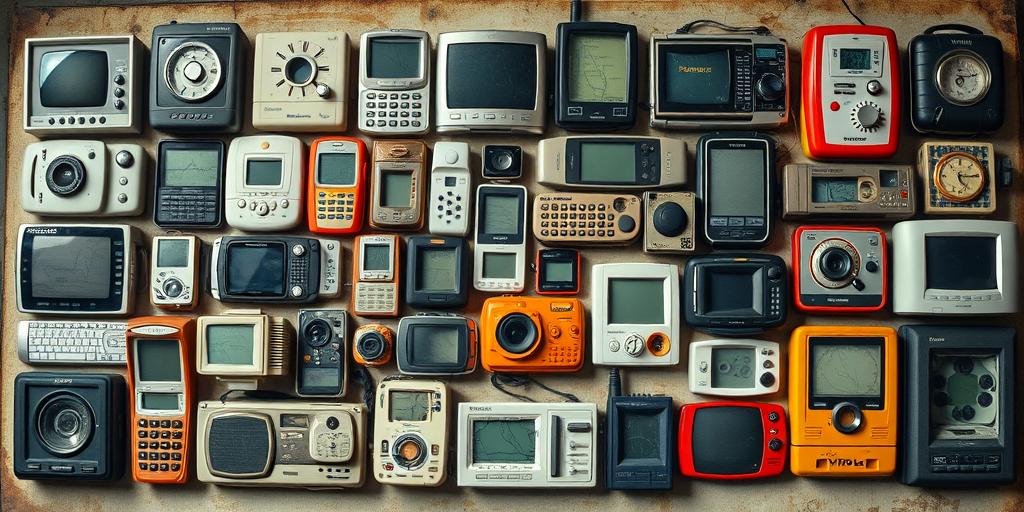Looking back at the evolution of technology is a fascinating journey, particularly when it comes to the gadgets that have shaped our lives. From clunky computers to sleek smartphones, the world of technology has undergone a dramatic transformation, leaving behind a trail of iconic gadgets that have become synonymous with specific eras. This Gadget History is a nostalgic overview of the rise and fall of these once-essential items, exploring the trends, innovations, and cultural impact they have had.
Introduction: A Journey Through Tech History
Our technological landscape is constantly evolving, with new gadgets emerging and older ones fading into obsolescence. It’s easy to get caught up in the latest trends, but taking a step back to appreciate the journey of technology can provide valuable insights into the forces driving innovation and the impact it has on our lives. This journey through Gadget History will explore the rise and fall of iconic gadgets, highlighting the key innovations that have shaped our world and the cultural significance of these devices.
The Golden Age of Innovation: 1970s-1990s
This period saw the birth of personal computing, mobile technology, and entertainment gadgets that revolutionized the way we lived, worked, and connected with the world.
The Dawn of Personal Computing: From Mainframes to Desktops
The 1970s marked the beginning of the personal computer revolution. Bulky mainframes gave way to desktop computers like the Apple II and IBM PC, making computing accessible to a wider audience. These early machines were revolutionary for their time, enabling people to perform tasks previously unimaginable.
The Rise of Mobile Technology: From Brick Phones to Pagers
The 1980s witnessed the rise of mobile technology with the introduction of brick phones like the Motorola DynaTAC 8000x. While these early mobile phones were expensive and bulky, they marked the beginning of a new era of communication. The 1990s saw the emergence of pagers, allowing for instant messaging and the ability to stay connected on the go.
The Entertainment Revolution: From Cassette Players to Walkmans
The 1970s and 1980s also saw the emergence of portable entertainment devices. Cassette players became ubiquitous, allowing people to listen to music anywhere. The Sony Walkman revolutionized personal audio, making it possible to enjoy music on the move. These devices transformed the way we consumed entertainment, making it more personal and accessible.
The Digital Age: 2000s-Present
The 21st century witnessed an explosion of digital technologies, with smartphones, social media, and the internet of things fundamentally reshaping our world.
The Smartphone Era: From Feature Phones to Touchscreens
The early 2000s saw the rise of feature phones, offering basic internet access and multimedia capabilities. However, the launch of the iPhone in 2007 marked a paradigm shift in the mobile industry. Touchscreen technology and the ability to download apps revolutionized the way we interacted with our devices.
The Rise of Social Media and Streaming Services
The 2000s also saw the rise of social media platforms like Facebook, Twitter, and Instagram, connecting people worldwide and transforming the way we communicate and share information. Streaming services like Netflix and Spotify revolutionized the way we consume entertainment, providing access to a vast library of content on demand.
The Internet of Things: Connecting Devices and Data
The Internet of Things (IoT) is transforming the way we interact with our surroundings. Connected devices like smart home appliances, wearables, and smart cars are collecting data and automating tasks, making our lives more convenient and efficient.
The Legacy of Iconic Gadgets: Lessons Learned and Future Trends
The rise and fall of iconic gadgets provide valuable insights into the forces driving technological innovation and the impact it has on society and culture.
The Impact of Innovation on Society and Culture
Iconic gadgets have not only transformed the way we live and work but also shaped our culture. The introduction of the personal computer led to the rise of the internet and the digital age, while smartphones have become an integral part of our daily lives, connecting us to information and each other in unprecedented ways.
The Importance of User Experience and Design
The success of iconic gadgets often comes down to their user experience and design. Devices that are intuitive, easy to use, and aesthetically pleasing tend to be more successful. The evolution of the smartphone, from clunky feature phones to sleek touchscreen devices, highlights the importance of design and user experience in driving adoption.
The Future of Technology: What’s Next?
The future of technology is likely to be driven by advancements in artificial intelligence, augmented reality, and virtual reality. We can expect to see even more connected devices, personalized experiences, and innovative solutions to everyday problems. However, as we move forward, it’s crucial to remember the lessons learned from the past.
Conclusion: A Nostalgic Reflection on the Evolution of Gadgets
Looking back at the Gadget History, it’s clear that technology has come a long way. From the early days of bulky computers to the sleek and powerful devices we use today, the evolution of technology has been nothing short of remarkable. These iconic gadgets have not only shaped our lives but also left an enduring legacy on our culture.
The enduring appeal of these gadgets lies in their ability to evoke memories and nostalgia. They remind us of a time when technology was simpler, yet still profoundly impactful. Remembering the past allows us to appreciate the progress we have made and to look forward to the exciting possibilities that lie ahead in the future of technology. As we continue to innovate and create new gadgets, it’s important to learn from the past and to ensure that technology remains a force for good, empowering us to connect, create, and explore new horizons.




